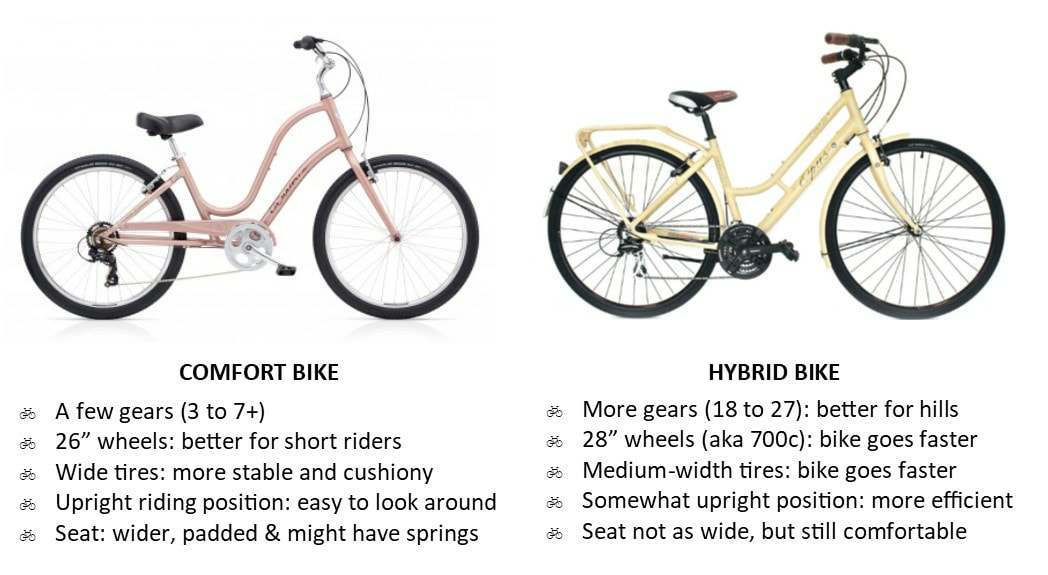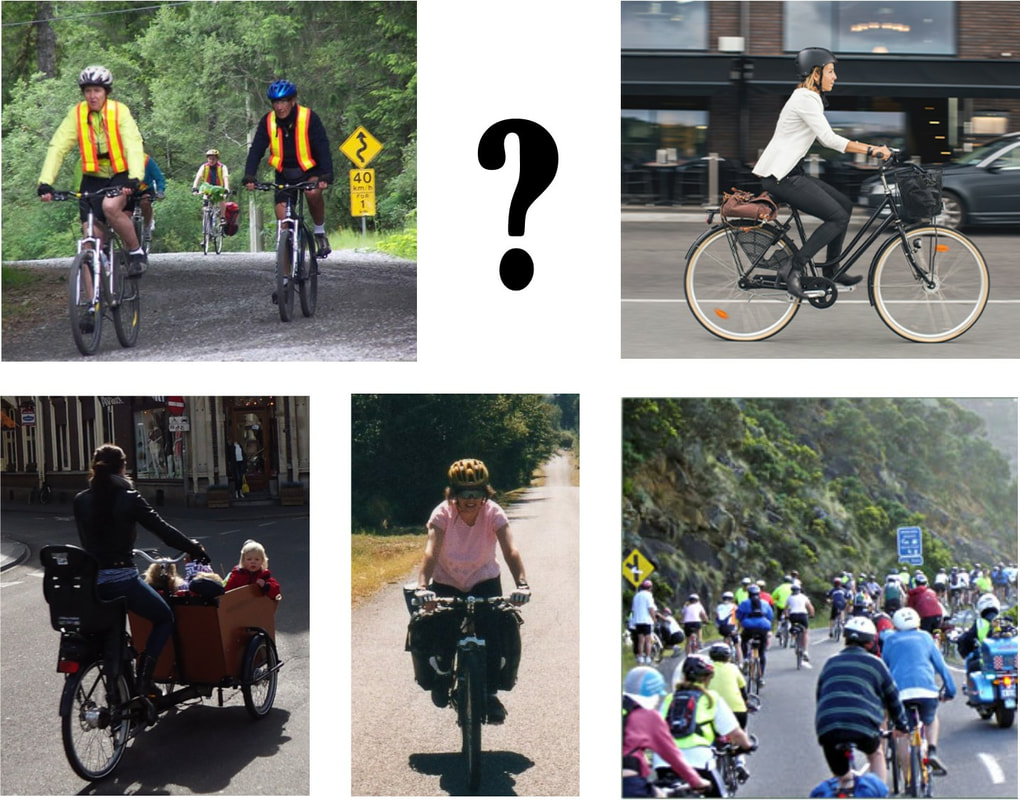If you are new to cycling, or getting back to it after a long break, chances are that you will be looking for either a comfort bike or a hybrid.
There are a few key differences between comfort and hybrid bicycles, highlighted below. Comfort bikes are for flattish terrain and shortish rides, emphasizing comfort over speed. Hybrid bikes can be ridden on most kinds of terrain, for short and long rides, and are also comfortable.
There are a few key differences between comfort and hybrid bicycles, highlighted below. Comfort bikes are for flattish terrain and shortish rides, emphasizing comfort over speed. Hybrid bikes can be ridden on most kinds of terrain, for short and long rides, and are also comfortable.
Of course, there are variations of bikes in between the above two examples, with respect to tire width and diameter, # gears, frame geometry, style of seat and overall weight.
Bicycles can also be modified: handlebars, seats and tires can be changed. You can have more gears put on. If you have problems with one hand, brakes and gear shifters can both be repositioned to one side. There are many possibilities to accommodate tricky joints and aging bodies.
Bikes come in different sizes, and getting the right size is important. Even though various components can be modified as described above, frame size is the one thing that can't be changed. Usually, your height determines the size of bike for you, but it can also depend on your leg length. This is one area where skilled bike shop salespeople make a difference: they can determine the best size and type of bike for you, as well as recommend suitable modifications.
Speed is not necessarily that important for everyday cyclists, but effort definitely is. So, when a bike can go faster, as hybrid bikes can (vs comfort bikes), what it really means is that less effort is required for a given speed. And, the higher number of gear options available on hybrid bikes means that going up hills is a lot easier. (OK, I admit that I am biased toward hybrid bikes).
Mountain bike and road bikes: In case you are wondering about these two other common types of bikes, I am not focusing on them because the former are designed for off-road riding over rough terrain, and the latter are built for speed on smooth roads.
You may also be interested in electric assist, if you want a bit of help with hills and longer distances. There are two possibilities: having an electric motor kit installed on your favourite bike, or buying a bicycle that is designed and built for electric assist (aka “e-bike”).
If you have serious concerns about falling, or you just like the idea of being cool in a laid-back position, adult trikes are an excellent option. They can also have electric assist.
One last plug for your local bike shop: Department store bikes may be cheaper initially, but you lose over the long term. You will see higher maintenance costs over time, malfunctions during rides, and a less comfortable ride experience overall. Plus, you aren’t supporting local small businesses, who care about your needs and service what they sell!
For some wise general bike-buying advice, check out Part 1 of What Kind of Bike Should I Get?
Blogposts coming up:
* All about e-bikes
* Why does it hurt? - aka Modifications that can be made to a bike
* Amazing things that other countries are doing to promote cycling
* Bike touring 101
* Nice places to cycle in Victoria
* How to start your own riding group
* How to ride in traffic 101
(not necessarily in this order!)
Bicycles can also be modified: handlebars, seats and tires can be changed. You can have more gears put on. If you have problems with one hand, brakes and gear shifters can both be repositioned to one side. There are many possibilities to accommodate tricky joints and aging bodies.
Bikes come in different sizes, and getting the right size is important. Even though various components can be modified as described above, frame size is the one thing that can't be changed. Usually, your height determines the size of bike for you, but it can also depend on your leg length. This is one area where skilled bike shop salespeople make a difference: they can determine the best size and type of bike for you, as well as recommend suitable modifications.
Speed is not necessarily that important for everyday cyclists, but effort definitely is. So, when a bike can go faster, as hybrid bikes can (vs comfort bikes), what it really means is that less effort is required for a given speed. And, the higher number of gear options available on hybrid bikes means that going up hills is a lot easier. (OK, I admit that I am biased toward hybrid bikes).
Mountain bike and road bikes: In case you are wondering about these two other common types of bikes, I am not focusing on them because the former are designed for off-road riding over rough terrain, and the latter are built for speed on smooth roads.
You may also be interested in electric assist, if you want a bit of help with hills and longer distances. There are two possibilities: having an electric motor kit installed on your favourite bike, or buying a bicycle that is designed and built for electric assist (aka “e-bike”).
If you have serious concerns about falling, or you just like the idea of being cool in a laid-back position, adult trikes are an excellent option. They can also have electric assist.
One last plug for your local bike shop: Department store bikes may be cheaper initially, but you lose over the long term. You will see higher maintenance costs over time, malfunctions during rides, and a less comfortable ride experience overall. Plus, you aren’t supporting local small businesses, who care about your needs and service what they sell!
For some wise general bike-buying advice, check out Part 1 of What Kind of Bike Should I Get?
Blogposts coming up:
* All about e-bikes
* Why does it hurt? - aka Modifications that can be made to a bike
* Amazing things that other countries are doing to promote cycling
* Bike touring 101
* Nice places to cycle in Victoria
* How to start your own riding group
* How to ride in traffic 101
(not necessarily in this order!)


 RSS Feed
RSS Feed